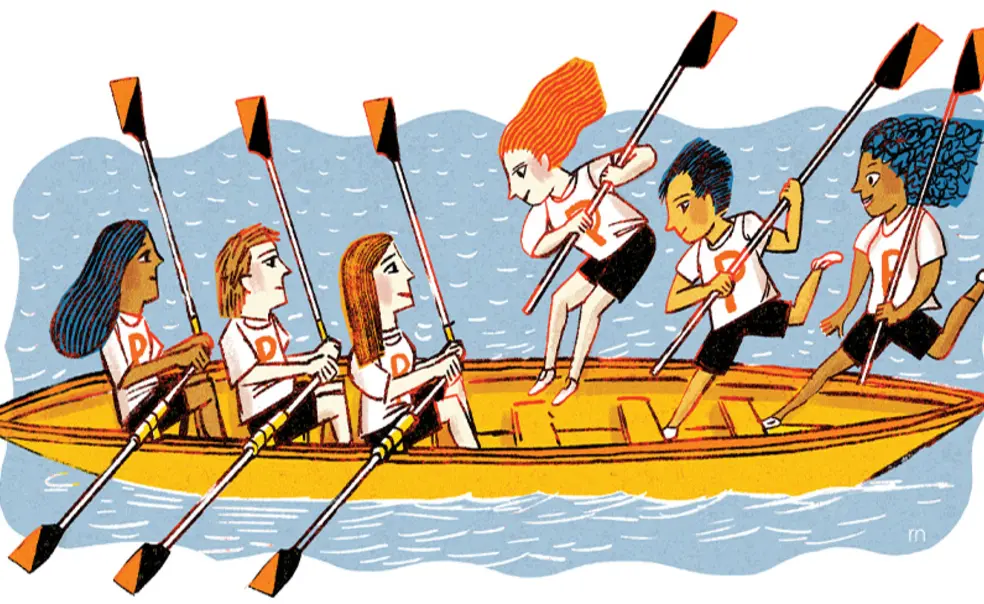Walk-On Tradition Helps Keep Rowing Teams Afloat
Outside the gates of the castle-esque Shea Rowing Center on the grassy Lake Carnegie shoreline, two dozen unfamiliar faces gather. They watch semitruck-length boats armed with massive oars glide past as butterflies fill their stomachs. Most have never touched an oar in their lives; soon their hands will be rubbed raw from handling them so much. Straightening their posture, the walk-ons prepare for the work ahead of them.

Unlike most varsity teams at Princeton, where nearly all athletes are recruited, rowing has long welcomed walk-ons, a tradition dating back to the team’s founding in 1870. Given the sport’s limited accessibility in the United States, novices make up a significant portion of rosters nationwide, with each Ivy League school maintaining its own walk-on program. It’s one of the few sports where driven newcomers, often with no prior experience, share a locker room with top athletes competing on the world stage.
Having walked on to the team as a coxswain last fall, my memories of this experience remain vivid. Now, I spend two hours every afternoon steering boats, shouting technique adjustments, and handling logistics for the team. It’s my favorite part of the day. Having loved it so much, I decided to follow three of this fall’s novices to capture their walk-on experiences.
The unexpected passion that many find for the sport often starts as a spark. Walk-on Margo Mattes ’27 remembers scrolling to an Instagram photo of the women’s openweight team winning the Ivy League championship last May. “Something about seeing the sport, seeing the girls win — I was like, ‘I have to do that,’” she said.
Rowers with some experience, like Mattes, who learned to row last summer, may be taken into a varsity crew immediately. For others, the walk-on process is more structured. On the men’s side, novice athletes spend three weeks learning technique in indoor rowing tanks, building endurance on the ergometer rowing machines (affectionately called “ergs”), and grinding through workouts on the boathouse lawn. Every hopeful member of the program — rower or coxswain — must participate.
Walk-on coxswain Bea Schlein ’29 appreciated being included. “By learning how to row and doing the workouts, I’m so much more prepared to give reasonable advice to the guys,” she said. “I know the work that goes into the sport.”
The crowd naturally begins to thin as the physical demands of the sport take their toll. By the fourth week, rowers undergo a 5-minute erg test and coaches make cuts to reduce the walk-on group to one eight-person crew.
Zach Wagner ’29 remembers the moment he made the cut this September. A few hours after finishing his erg test, he received a congratulatory email and an invitation to the boathouse for the next day’s practice. “I got a text from one of my friends: ‘Are we gonna be rowing tomorrow, Wagner?’” he said. “I replied, ‘Yes we are!’”
After the cut, it’s finally time to get on the water. An entire day is spent just learning how to walk a boat to the dock, and when it’s time to take the first strokes on the water, things are shaky as the crew learns to move as one. At the time of writing, Schlein and Wagner were both in this uneasy first week. By the second week, the boat will cease to crash from side to side. By late October, the crew will start to move at a decent speed.
In early November, the novices will compete in the Princeton Chase, the symbolic finale of the walk-on program. If successful, they will be sorted into the heavyweight and lightweight teams to continue their paths as varsity athletes.
It’s a crash course that has produced generations of Princeton rowers. To reach the finish line, it helps to follow the advice Wagner received from Johnny Inman, an assistant coach for the men’s heavyweight team who directs the novice crew: “Coach Johnny always says, ‘It’s just the next stroke. The most important thing is the next stroke.’”











5 Responses
Jim Moses ’88
4 Weeks AgoLearning and Bonding as Crew Walk-ons
As a walk-on to the lightweight crew in the fall of ’84, I enjoyed reading this article quite a bit. As freshmen, we fielded two boats, the 1F and 2F. If memory serves, 11 out of 18 of us were walk-ons. In ’88, our senior year, the varsity consisted of three boats and 17 out of 27 were walk-ons. As the freshman lightweight coach in ’89, my two boats had 13. Walk-ons, most of whom played soccer, lacrosse, or ran cross country and track in high school, were critical to the depth and success of the program. I’ve been curious to know whether walk-ons comprise as significant a proportion of the squads since the freshman and novice programs were absorbed by the varsities some years ago. My hunch is they do not. Those programs allowed good athletes the time and space to learn technique and bond as a class. That seemed consistent with a liberal arts education.
William H. Nelson *73
1 Month AgoRowing Experience Endures
Although I got my master’s and Ph.D. degrees from Princeton, it was as an undergraduate at MIT that I was a crew walk-on, never having been in a shell before, having to compete against a crop of much taller very experienced rowers. But I made the heavyweight varsity, beating Harvard twice. And now, I’m still rowing in my 80s, doing 8 kilometers every other morning in a single on a nearby lake.
Jim Newcomer ’57
1 Month AgoFrom Walk-ons to Eastern Champs
A great tradition, with new encumbrances as life has grown more complex.
I was a walk-on in the fall of 1953. I had been a trumpet player in high school on the West Coast; my only rowing experience had come in Sea Explorer whaleboat races on the Columbia River. But the lure of rowing in a real shell grabbed me at Princeton and would not let go.
In the end I was captain of the lightweight men’s eight that captured the EARCs and the Thames Challenge Cup in both 1956 and 1957. Great crews, nearly all of us had walked on.
William Price ’66
1 Month AgoMemories of Rowing as a Walk-on
In the fall of 1962, most of us who turned up for freshman lightweight crew were new to the sport. Coach Al Povey got us learning to row right away — on the barge with sliding seats. There were no rowing machines or “ergs” for training, just rowing and running. The boathouse only had racks for the boats, showers, and a carpentry shop to repair the continual splits in the thin wooden shells. The klutzes occasionally “caught a crab”; the mighty could break a (probably damaged) oar.
Phil Hansen ’66
1 Month AgoLasting Impact of Learning to Row
I was a walk-on (as were we all) in September of 1962, and I’m still sweep rowing in the 80+ category. I’m glad we’re keeping that door open.